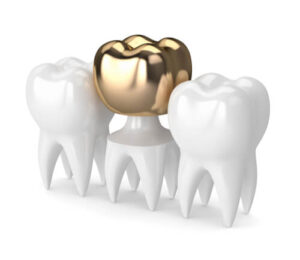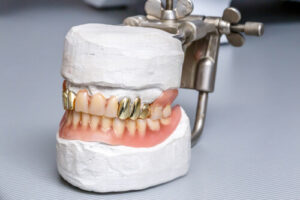In the dynamic landscape of cosmetic dentistry, the quest for the perfect smile often leads individuals to explore various options for dental crowns that enhance their teeth’ aesthetics and ensure longevity and durability. Among these innovative solutions, the permanent gold tooth implant emerges as a distinctive choice, marrying the timeless allure of gold with cutting-edge dental technology. Join us as we explore the intricacies of this remarkable dental option, its application process, and how it stands as a testament to the innovative strides in modern dentistry.
Introduction to Permanent Gold Tooth Implants
The integration of gold into dental restorations is a practice steeped in history. Yet, it continues to play a pivotal role in advancing modern dental care through permanent gold tooth implants. These gold teeth implants represent a fusion of aesthetic desires with functional necessities, offering a solution that is not just about restoring a smile but enhancing overall dental health with a material known for its durability and biocompatibility.
Historical significance and modern innovation
Gold has been utilized in dental procedures for centuries because of its durability and aesthetic appeal. Today, permanent gold tooth implants continue this tradition, combining the timeless allure of gold with contemporary dental technology to solve missing or unhealthy teeth.
Gold crowns and fillings
Once primarily used for crowns and fillings, gold is celebrated for its strength and minimal wear on opposing teeth, making it an ideal material for dental restorations that require both longevity and aesthetic appeal.
Permanent solution for tooth replacement
Unlike temporary solutions, such as removable crowns or bridges, permanent gold tooth implants offer a long-term answer to tooth loss. They provide a stable, durable foundation to last a lifetime.
Benefits over other materials
Gold implants are favored over other materials like porcelain or composite fillings for their compatibility with the body, resistance to corrosion, and reduced impact on surrounding natural teeth, ensuring a healthier oral environment.
Minimal tooth removal is required.
Placing gold implants typically requires less removal of the existing tooth structure than other dental restoration methods, preserving more of the natural tooth and promoting overall dental health.
Aesthetic and functional enhancement
Gold tooth implants restore the functionality of missing or damaged teeth and offer a unique aesthetic appeal, allowing individuals to customize their smiles with the distinctive look of gold.
Personal preference and dental health
Choosing a gold tooth implant reflects a preference for gold’s aesthetic and physical properties while addressing dental health needs, such as replacing missing teeth or restoring unhealthy teeth to a natural, healthy state.
Benefits of Choosing a Gold Tooth Implant
Opting for a gold tooth implant presents many benefits beyond mere aesthetics, making it a compelling choice for individuals seeking dental restorations. Gold teeth fillings, with their remarkable properties, offer a unique combination of durability, biocompatibility, and aesthetic appeal that is hard to match with other dental materials. As we delve into the advantages of choosing a gold tooth implant, it becomes evident that this option is about making a style statement and ensuring long-term dental health and functionality.
Unmatched Durability: Gold’s exceptional durability stands at the forefront of its benefits. Gold tooth implants are known for their ability to withstand the rigors of daily use, including the forces of biting and chewing, without succumbing to wear or damage. This resilience ensures that gold implants can last for decades, providing a permanent solution for tooth replacement that is reliable and cost-effective in the long run.
Superior Biocompatibility: Another significant advantage of gold is its biocompatibility. Gold tooth implants are well tolerated by the body, decreasing the risk of allergic reactions or rejection. This compatibility is crucial for the long-term success of the implant, ensuring that it integrates seamlessly with the surrounding tissue and bone.
Aesthetic Versatility: While the aesthetic preference for gold varies among individuals, gold tooth implants offer a unique and distinguished appearance. For those who appreciate the classic look of gold, these implants can serve as a fashion statement or a personal expression, all while providing the functional benefits of a traditional dental implant.
Minimal Wear on Opposing Teeth: Gold is softer than porcelain and other materials used in dental restorations, which means it causes less wear on opposing natural teeth. This property is especially beneficial for preserving the health and integrity of the remaining natural teeth, ensuring a balanced and healthy bite.
Corrosion Resistance: Gold’s resistance to corrosion is unparalleled. Gold maintains its integrity and appearance, unlike other materials that may tarnish or corrode over time when exposed to saliva and foods. This resistance contributes to the longevity of the implant and maintains its aesthetic appeal for years to come.
Ease of Maintenance: Caring for gold tooth implants is straightforward and requires no special maintenance beyond regular dental hygiene practices. The durability and corrosion resistance of gold ensures that the implant remains in excellent condition, making it a convenient choice for those looking for a low-maintenance option.
Health Benefits: Beyond the aesthetic and functional benefits, gold tooth implants can contribute to overall oral health. Their stability and biocompatibility help prevent bone loss and gum recession, common issues with missing teeth, thereby supporting the health of surrounding teeth and tissues.
Understanding the Procedure: From Consultation to Implantation

Embarking on the journey of getting a gold tooth implant involves a multi-step process that begins with an initial consultation and culminates in the implantation of the gold tooth crown restoration. This procedure aims to replace missing teeth or restore those affected by decay or injury and to ensure the integration of the implant with the natural anatomy of the patient’s mouth. Understanding each phase of the process, from consultation to implantation, is crucial for patients to set realistic expectations and prepare adequately for the outcomes.
Initial Consultation: The first step towards getting a gold tooth implant is a thorough consultation with a dental professional. During this meeting, the dentist evaluates the patient’s oral health, discusses their aesthetic and functional needs, and determines the suitability of a gold tooth implant. This stage often involves taking X-rays or 3D images to assess the condition of the jawbone and surrounding tissues.
Treatment Planning: The dentist devises a personalized treatment plan based on the initial assessment. This plan outlines the specific steps of the implant procedure, including any preparatory work needed to ensure the success of the implant, such as bone grafting in cases where the jawbone is not dense enough to support the implant.
Preparatory Procedures: If required, preparatory procedures like bone grafting are performed to create a solid foundation for the implant. This step is essential for patients with insufficient bone mass or density, ensuring the implant will be stable and secure.
Implantation of the Gold Tooth involves surgically placing the gold tooth implant into the jawbone. The procedure is typically performed under local anesthesia to minimize discomfort. Once the implant is in place, it needs time to integrate with the bone, a process known as osseointegration, which can take several months.
Healing and Osseointegration: After the implantation, a healing period is required for the implant to fuse with the jawbone securely. This phase is crucial for the implant’s stability and involves careful monitoring by the dental professional to ensure successful integration.
Placement of the Abutment: Once osseointegration is complete, an abutment is attached to the implant. This component is a connection point for the permanent gold teeth crown and is placed during a minor surgical procedure.
Fitting of the Gold Crown: The final step in the process is fitting the gold crown onto the abutment. The crown is custom-made to match the shape, size, and color of the patient’s natural teeth, ensuring a seamless integration into their smile.
Caring for Your Gold Tooth Implant: Maintenance and Hygiene

Maintaining the longevity and appearance of your gold tooth implant requires diligent care and hygiene practices similar to those for natural teeth yet tailored to ensure the gold alloy implant’s durability and health. Proper maintenance not only safeguards the aesthetic appeal of the gold implant but also supports overall oral health, preventing issues such as gum disease and implant failure. By adopting a comprehensive care regimen, patients can enjoy the benefits of their gold tooth implant for many years.
Regular Brushing and Flossing: The cornerstone of gold tooth implant care is regular brushing and flossing. This daily routine removes plaque and prevents bacteria buildup around the implant and the gum line. Using a soft-bristled toothbrush and non-abrasive toothpaste can help maintain the luster of the gold while protecting the surrounding gum tissue.
Use of Non-abrasive Dental Products: It’s essential to choose non-abrasive dental care products to avoid scratching the surface of the gold implant. Toothpaste designed for sensitive teeth or dental implants is ideal, as it effectively cleans without causing wear to the gold surface.
Routine Dental Check-ups: Consistent dental check-ups and professional cleanings play a vital role in preserving the condition of your gold tooth implant. Attending these appointments facilitates the timely identification and management of any arising problems, such as gum disease or the loosening of the implant.
Avoiding Hard Foods: Although gold is durable, avoiding hard and sticky foods can prevent unnecessary stress on the implant. Foods requiring significant force to bite through can damage the gold crown and the underlying structure.
Quitting Smoking: Smoking can impede the healing process and negatively affect the longevity of dental implants. Quitting smoking is advisable to reduce the risk of implant failure and to promote overall oral health.
Alcohol Consumption in Moderation: Excessive alcohol consumption can also affect the health of your implant. Moderation is key, as alcohol can dry the mouth and reduce saliva production, which is essential for neutralizing acids and cleaning the teeth and gums.
Immediate Attention to Issues: Any signs of discomfort, loosening, or damage to the gold tooth implant should prompt an immediate consultation with a dental professional. Prompt action can avert severe complications and guarantee the extended durability of the implant.
Comparing Gold Implants to Other Dental Implant Materials
The choice of material for dental implants is critical, as it affects the implant’s durability, biocompatibility, aesthetic appeal, and patient satisfaction. Gold has been a preferred material for dental restorations for centuries, but with advancements in dental technology, various materials are now available for implants. Comparing gold implants to other dental implant materials reveals a nuanced landscape. Each material offers distinct advantages and considerations, helping patients and dental professionals make informed decisions based on specific needs and preferences.
- Aesthetic Appeal: For patients prioritizing aesthetics, gold offers a unique and distinguished appearance, although it may not mimic the natural look of teeth as closely as other materials. Porcelain and zirconia implants, in contrast, can be color-matched to adjacent teeth, offering a more natural appearance. However, the aesthetic value of gold, particularly for visible restorations, remains a matter of personal preference.
- Cost Considerations: Gold implants are often more expensive upfront due to the material cost. However, their durability and longevity can make them a cost-effective option over time. Materials like titanium and zirconia may have lower initial costs but also offer long-term value based on their own sets of benefits and potential maintenance needs.
- Maintenance and Care: Gold’s ease of maintenance is a significant advantage, as it requires no special care beyond regular oral hygiene practices. While porcelain and zirconia also demand good oral hygiene, they may require more cautious handling to prevent chipping or cracking.
- Strength and Wear on Opposing Teeth: Gold’s softness relative to natural tooth enamel minimizes wear on opposing teeth, an important consideration for oral health. Porcelain, while strong, can be more abrasive to adjacent natural teeth if not finely polished.
- Specific Applications: The choice of material may also depend on the specific application, with gold being preferred for certain types of crowns and bridges due to its workability and aesthetic qualities. Titanium and zirconia are often chosen for their strength and biocompatibility for the implant posts that integrate with the jawbone.
The Cost and Investment Analysis of Gold Tooth Implants

The decision to opt for a gold tooth implant is not just a matter of aesthetic preference or durability but also involves carefully considering the cost and long-term investment of permanent gold teeth. Gold tooth decay, known for its timeless appeal and exceptional physical properties, commands a higher price point in the dental restoration market. However, when analyzing the cost of gold tooth implants, it’s essential to weigh the initial investment against its long-term benefits and savings, making it a viable option for many seeking a balance between quality, longevity, and overall value.
- Initial Cost: The upfront cost of gold tooth implants is typically higher than that of other materials due to the intrinsic value of gold and the craftsmanship in customizing the implant to fit the patient’s mouth. This initial expense covers the material and labor-intensive process of designing and fitting the implant.
- Durability and Longevity: One of the most important reasons to choose gold for dental implants is its unparalleled durability. Gold implants can last a lifetime with proper care, potentially reducing the need for future replacements or repairs that are more common with other materials.
- Maintenance and Repair Costs: Gold’s resistance to corrosion and wear also means minimal maintenance and repair costs. Gold maintains its integrity, leading to lower long-term maintenance expenses than other materials that may chip, crack, or degrade, necessitating additional dental work.
- Aesthetic Value: For those who value the unique aesthetic of gold, the cost can be justified by the personal satisfaction and confidence gained from the implant. While difficult to quantify, the aesthetic appeal of gold may be worth the investment for individuals who prioritize this aspect of their dental restorations.
- Insurance and Financing Options: When evaluating the cost of a gold tooth implant, it’s important to consider insurance coverage and financing options. Some dental insurance plans may cover a portion of the cost, and many dental offices offer financing plans to help manage the expense, making gold implants more accessible.
- Comparative Analysis with Other Materials: When comparing gold to other implant materials, such as titanium or zirconia, the analysis should extend beyond initial costs to include longevity, maintenance, and aesthetic value. Although gold may have a higher initial price, its long-term benefits and durability may offer greater value.
- Return on Investment: Ultimately, choosing a gold tooth implant can be seen as a long-term investment in oral health and quality of life. The combination of durability, low maintenance, and aesthetic appeal can offer returns that justify the initial cost, making it a worthwhile consideration for those seeking a premium dental restoration option.
Choosing a permanent gold tooth implant offers a blend of durability, aesthetics, and a nod to dental tradition with a modern twist. This investment enhances your smile and promises long-lasting satisfaction and functionality. As dental technology advances, the appeal of implanted gold teeth implants remains timeless, making it a noteworthy option for those seeking both quality and character in their dental care. Consider making this unique choice to elevate your oral health and aesthetics.
References
Permanent Gold Teeth Guide: Implants, Crowns, & Grillz – Dentaly.org
https://www.dentaly.org/us/restorative-dentistry/permanent-gold-teeth/
Gold Dental Implant-Induced Oral Lichen Planus – PMC
https://www.ncbi.nlm.nih.gov/pmc/articles/PMC8901106/
Dental treatments – NHS
https://www.nhs.uk/live-well/healthy-teeth-and-gums/dental-treatments/
newGold Crowns: Tooth: Cost and Comparison to Porcelain
https://www.healthline.com/health/gold-crown-tooth
How Much Do Dental Implants Cost? (2024) – Forbes Health
https://www.forbes.com/health/dental/how-much-dental-implants-cost/
